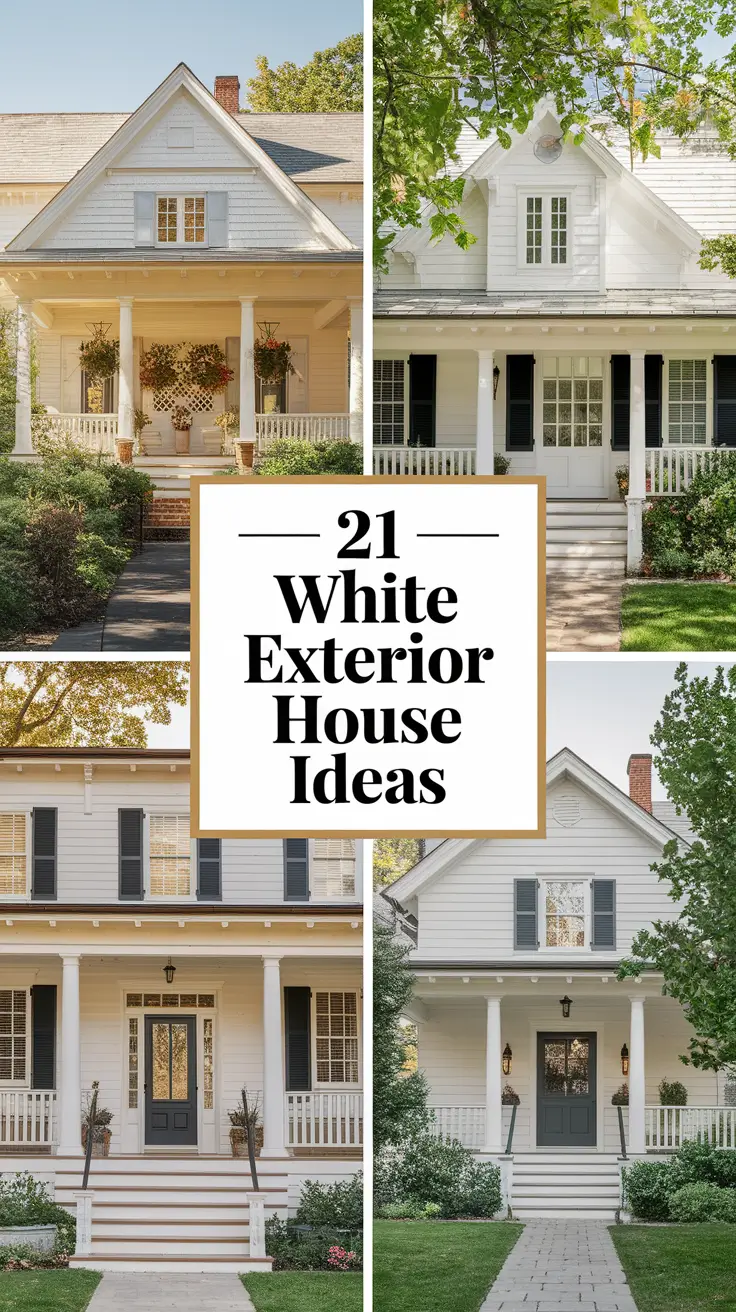21 White Exterior House Ideas That Elevate Curb Appeal With Style and Contrast

Why do white exterior houses always seem to be a timeless choice? What effect can wood accents, black trim or a beautiful color scheme have on your home’s curb appeal? I’ll show you 21 examples in this article that demonstrate how a white façade can be anything but plain. You’ll learn how to add charm, contrast and texture to your home by using white exterior paint with these different ideas. Whether you’re planning a renovation or designing your dream home, these examples offer inspiration grounded in design best practices and real-world functionality.
The Allure Of A White Exterior House
There’s a timelessness to a white exterior house that never goes out of style. I have always liked that clean lines and neutral colors can make a room look both calm and elegant. White looks wonderful in any style of home, especially classic colonials and modern farmhouses, as it brightens the area and highlights the textures. It also forms a flexible foundation for interesting contrasts with black trim, natural wood features or grey stone walkways.
For white exterior projects, I choose materials that go well with the paint, rather than clash with it. Think vertical board-and-batten siding, painted brick, and smooth stucco. The look of your home can be set by including matte black lights, wood-colored garage doors and modern landscaping edges. This creates a well-organized front yard that looks organized and above average.
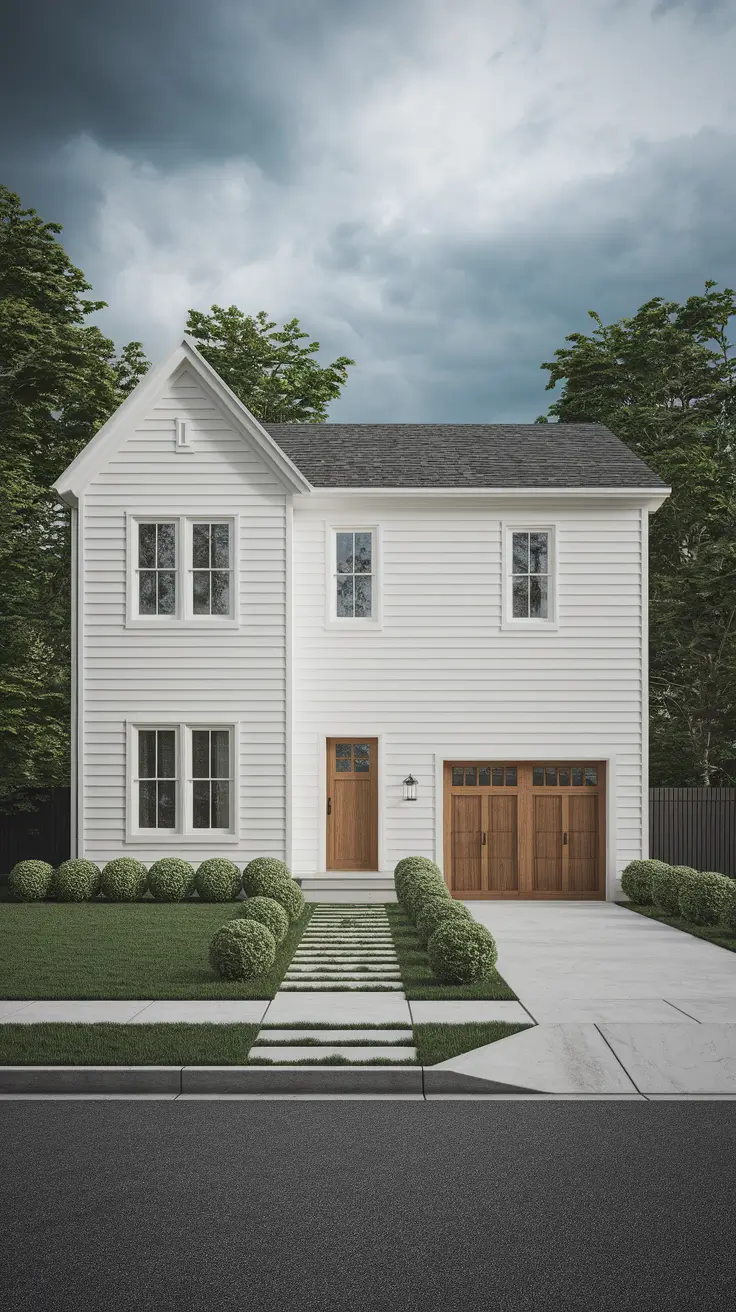
During my renovation, I found that changing the white exterior paint color just a bit can make a home feel either warm or cool or rustic or minimalist. For example, Dover White (by Sherwin-Williams) is a soft, creamy white that balances brightness without harshness. HGTV recommends including different textures and finishes when choosing white which is advice I also give.
I’d like to see more care given to the color of the trim in homes. A lot of homeowners pick white-on-white, but using a soft grey or sandy brown instead can make the space look much more interesting.
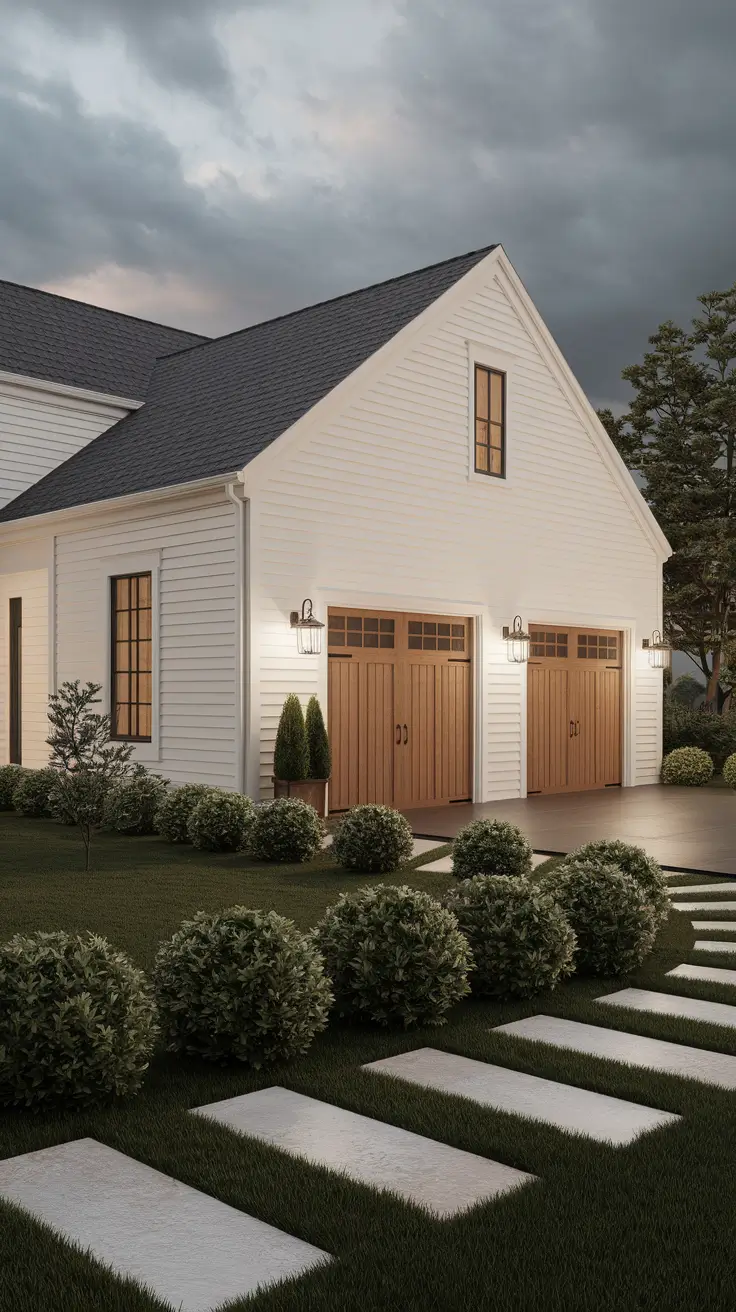
Why White Exterior Homes Remain a Classic Favorite
The white exterior house isn’t a trend—it’s a design staple. I’ve seen over the years that many clients choose white because it looks clean, elegant and inviting. It looks wonderful in both suburban and city areas. Because white is neutral, it is simple to use different materials and colors to make a space stand out.
I usually use symmetry and contrast while designing a classic white exterior. Imagine siding that’s white, dark shutters and a door painted navy or forest green. Adding flower boxes or brushed nickel hardware can easily make the home look more elegant. A rich lawn or neatly trimmed hedges make the front of the house look even better.
Personally, I find that white enhances architectural geometry. It clearly shows the rooflines, collections of windows and columns found on porches. Better Homes & Gardens says that white homes are easier to sell because many people find them attractive. I have noticed the same thing happening with property values.
The quality of the painting can sometimes be missed when considering a painting. You should refresh white more often to keep it looking fresh. I always suggest high-durability, mildew-resistant finishes for longevity.

Choosing The Right White Exterior House Colors
Selecting white exterior house colors is more nuanced than people assume. I’ve noticed that small touches of yellow, grey or beige can either help or hurt the overall impact. The wrong white can make a room feel cold or dull which is why you need to consider the sun, your roof’s color and any plants nearby.
For homes that are mostly shady, I suggest choosing whites with warm creamy or beige colors. If you want a bright white look outside, Extra White or Pure White are good choices that won’t be too bright. If you’re going to use brick, wood or stone, think about how the color will go with them.
If you’re looking for a good white paint, I suggest Benjamin Moore’s Simply White or Sherwin-Williams’ Alabaster. Real Simple even dubbed them “designer favorites for a reason.” I show clients sample boards in natural light to help them make their choices.
I’d recommend trying out your color samples in the morning, at midday and at dusk. White can look different at different times, so it’s important to have a choice that is both flexible and consistent.
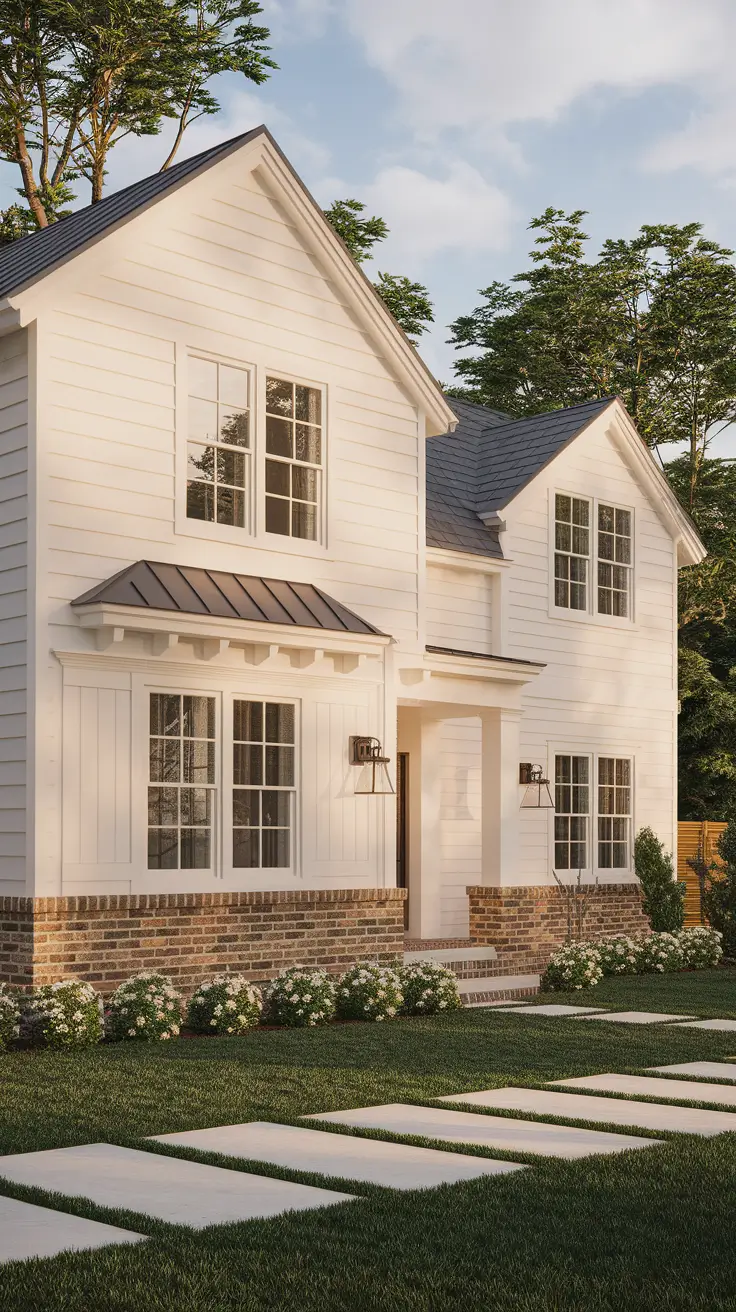
Trending White Exterior House Paint Options
Lately, I’ve noticed a shift toward layered and textured white exterior house paint schemes. Rather than using a plain white, designers are now choosing warmer or greyish whites. These new options match well with both current and farmhouse styles, especially when used on houses with mixed materials.
On large areas outside, I usually advise choosing flat or satin finishes. They cover up any flaws and produce a calm, elegant look. For trim, I choose semi-gloss to add a bit of difference to the walls. It’s now common to use Alabaster white siding, black trim and cedar details together.
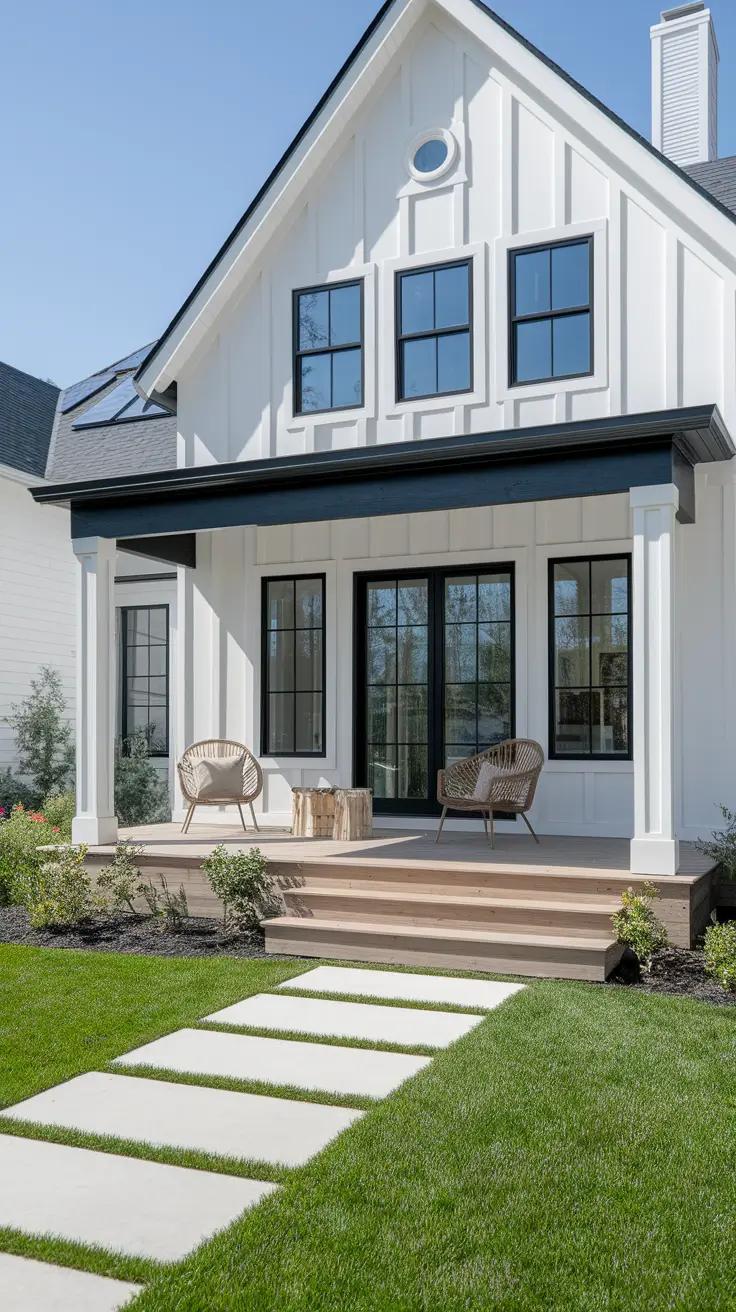
When you use Sherwin-Williams or Behr’s acrylic latex paints, you can count on them lasting longer. Martha Stewart Living recently explained that for a deck to last, it needs to be protected from UV rays and mildew.
People often forget that sheen can make a difference—high sheen can reveal blemishes and very flat sheen can look boring. I think it’s important to discuss finish options more during paint consultations.
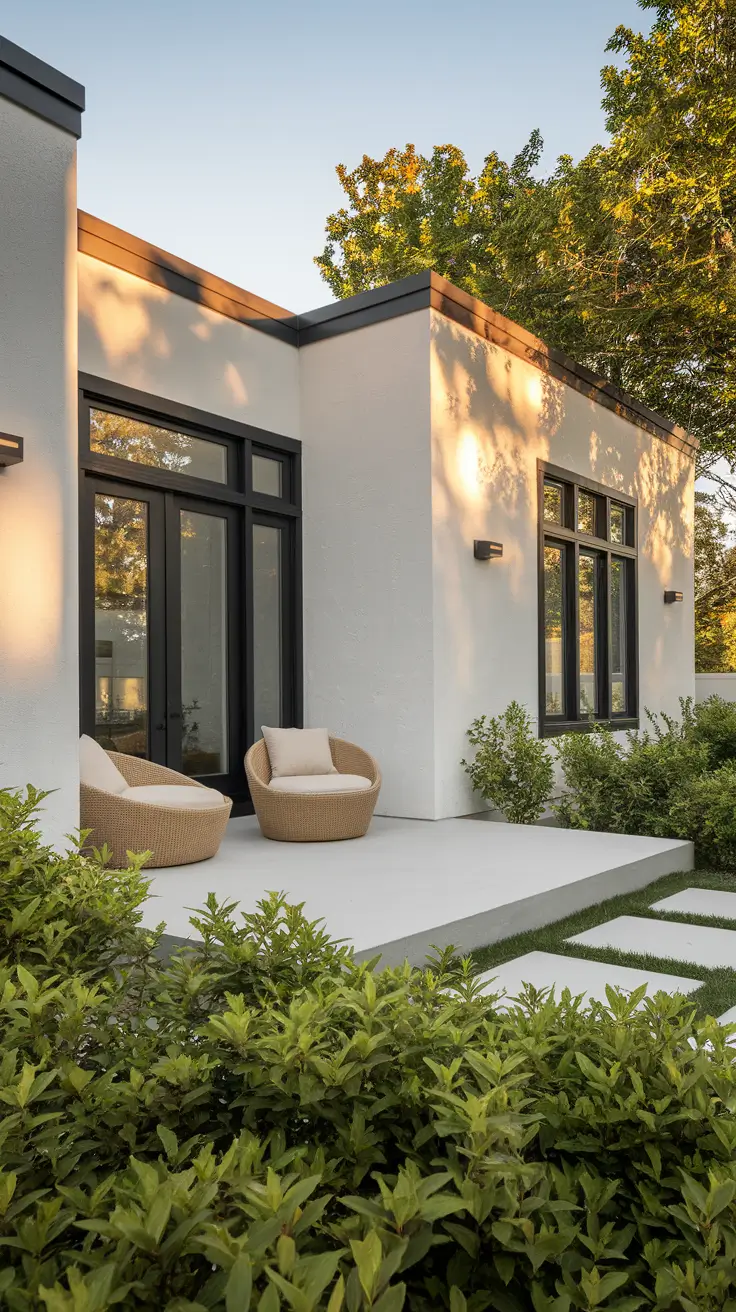
Stunning White Exterior House With Wood Accents
Combining a white exterior house with wood accents is one of the most visually compelling strategies I’ve worked with. The presence of natural wood gives a white space a sense of balance and earthiness. No matter if it’s cedar, teak or reclaimed barn beams, this duo suits both traditional coastal homes and modern cabins.
When building, I prefer to use vertical wood slats on gables and entry overhangs and I surround porch posts and garages with natural timber frames. Wooden window shutters or planters can bring all the elements of your home together. The brown wood gives the white a softer look and also makes the home’s textures more varied.
I like what Studio McGee does in this area—their farmhouse designs use white siding and oak soffits and accents to create a welcoming and stylish style. It’s important to use a UV-resistant finish on the wood to keep its color from fading.
I’d love to see more wood used in outdoor furniture, so it matches the wood features inside the house.

Fresh White Exterior House Paint Colors To Try
Each year brings new spins on white exterior house paint colors, and I make it a point to stay updated on the freshest tones available. This year, you’ll see creamy off-whites, warm eggshells and bright matte finishes becoming popular. These shades give your home character without losing the classic look white is famous for.
I’ve found White Dove by Benjamin Moore and Swiss Coffee by Behr to be very successful for me. They look particularly lovely when combined with black windows, grey roofs or brown garage doors. These combinations offer sophistication without feeling too rigid.
Architectural Digest often points out that it’s important to paint swatches on the outside of your home. I always do this, as it’s a great way to make sure the color suits brick, stone or wood accents.
What’s often missing in this conversation is seasonal adaptability. Whites that appear lovely in the sun can look dull or too pale in the winter. I suggest my clients do a few tests in the darker months as well.
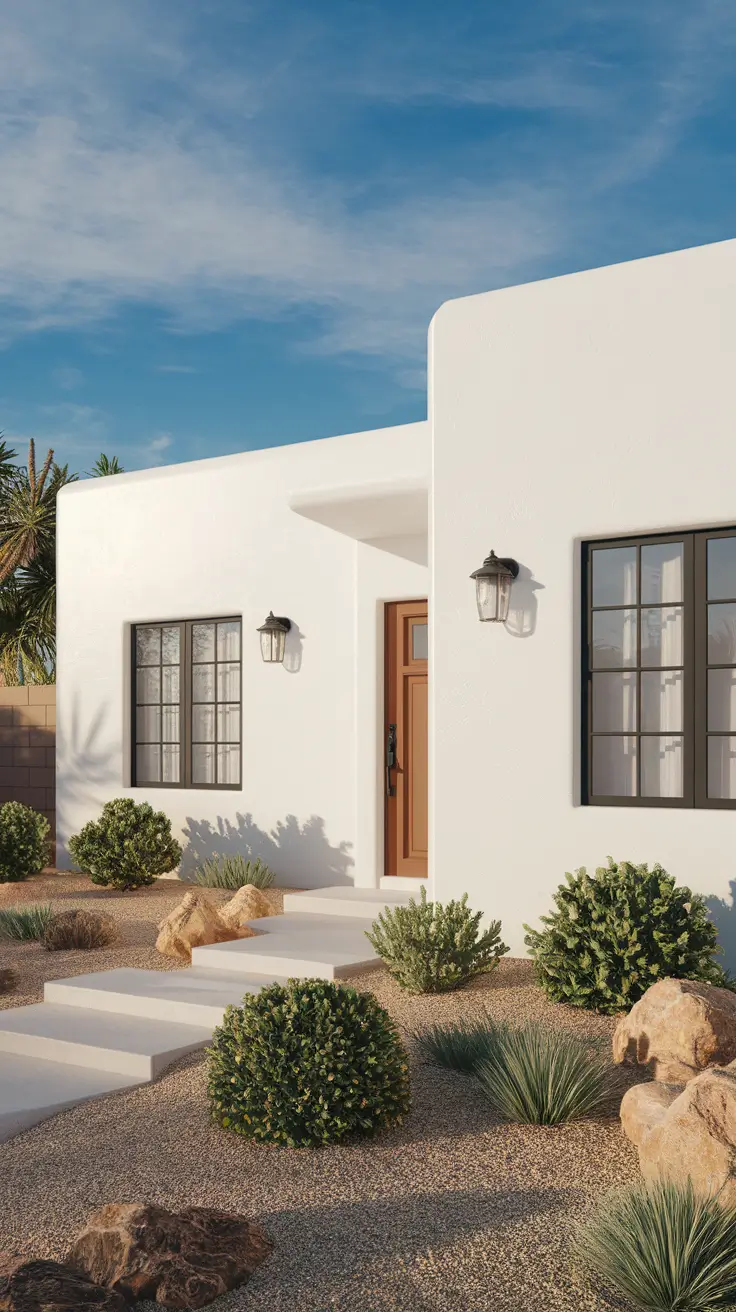
Modern White Exterior House With Black Trim
The modern white exterior house with black trim is a high-contrast style that I’ve loved working with recently. It blends clean architectural lines with dramatic visual framing. The clear black lines against the white siding make the house look both clean and strong. It works well in modern ranches, in Scandinavian designs and in new American homes.
These homes suit me best when the exterior is stucco or Hardie board in very bright white. Having black gutters, window frames and door surrounds adds a strong, architectural feel to the home. I usually add matte black lighting, house numbers and railings to connect the design.
Personally, this is an affordable way to get a modern, luxury style in your home. It’s visually balanced and low maintenance if done correctly. Dwell Magazine recently pointed out that this style is now being called the “new classic,” and I completely agree.
A great way to improve this look is to add modern landscaping such as black gravel borders or geometric hedges, to highlight the home’s symmetry.

Designing A White Exterior House With White Windows
When designing a white exterior house with white windows, the challenge lies in creating dimension without relying on color contrast. I think this style is very classy when it uses different materials, layered planting and gentle highlights. This monochromatic look offers a minimalist charm that’s perfect for modern beach homes, Cape Cod architecture, or streamlined suburban properties.
I like to use different types of white on walls and window trim such as matte and semi-gloss, to make the space more interesting and bright. Wood siding or painted brick on the walls gives the home a strong appearance. A stone border, wooden door and brushed nickel hardware add more character to the home without changing the white color scheme.
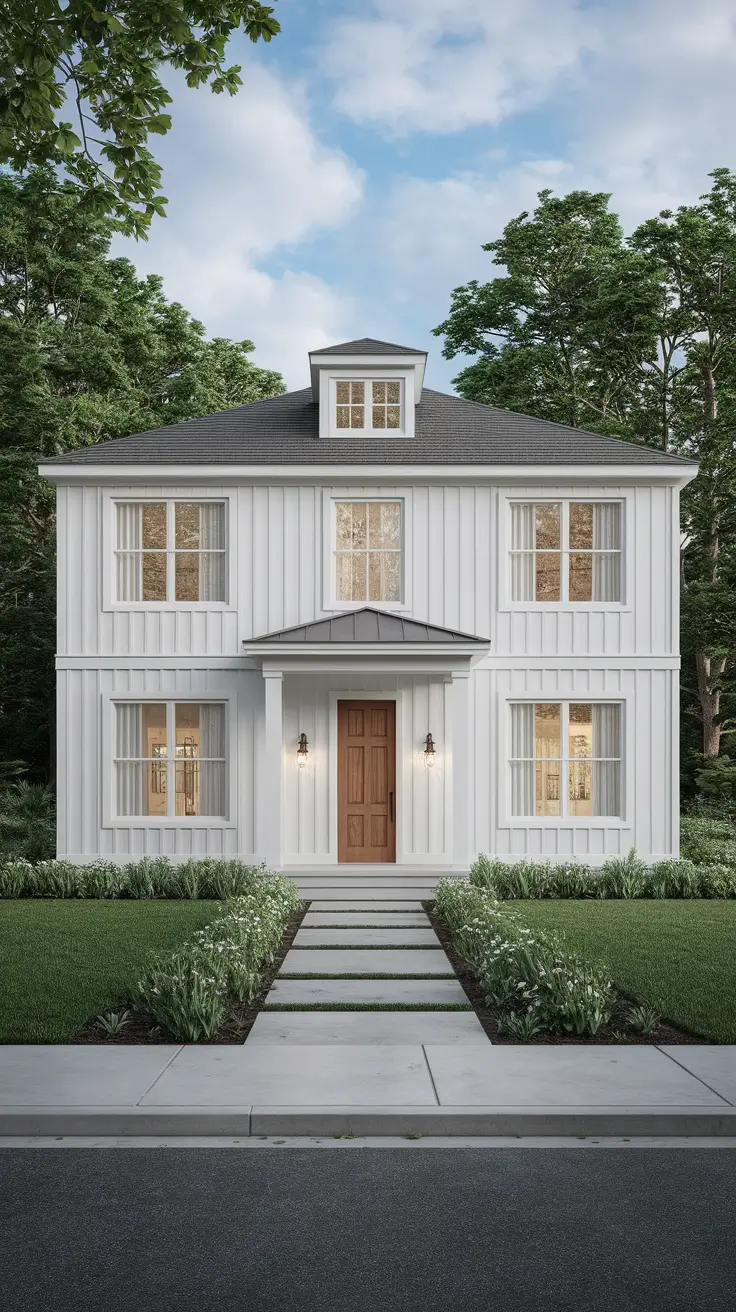
In my opinion, this design feels peaceful and unified. Many clients who like a quiet, elegant look choose this style. White-on-white homes are becoming more popular for holiday homes, especially close to the coast, according to Southern Living. The key is restraint—overcomplicating the materials ruins the effect.
This style could be made even better with lots of green plants—hedges, potted shrubs or ivy—that help the home’s brightness stand out.

Chic White Exterior House Ideas For Every Style
No matter your architectural preferences, there’s a white exterior house idea that fits. I’ve designed traditional homes, craftsman bungalows and modern ranches, all of which looked great in white. The secret is to pick your finishes, accent materials and room layouts to emphasize the home’s personality.
In some cases, a craftsman home has white shiplap and a brown wooden pergola, while a modern home often uses stucco and black windows. I usually advise making your home’s exterior fit in with the area—white adobe in the Southwest or painted brick in the South. Even the most modern container homes seem more impressive when their white walls are matched with simple landscaping.
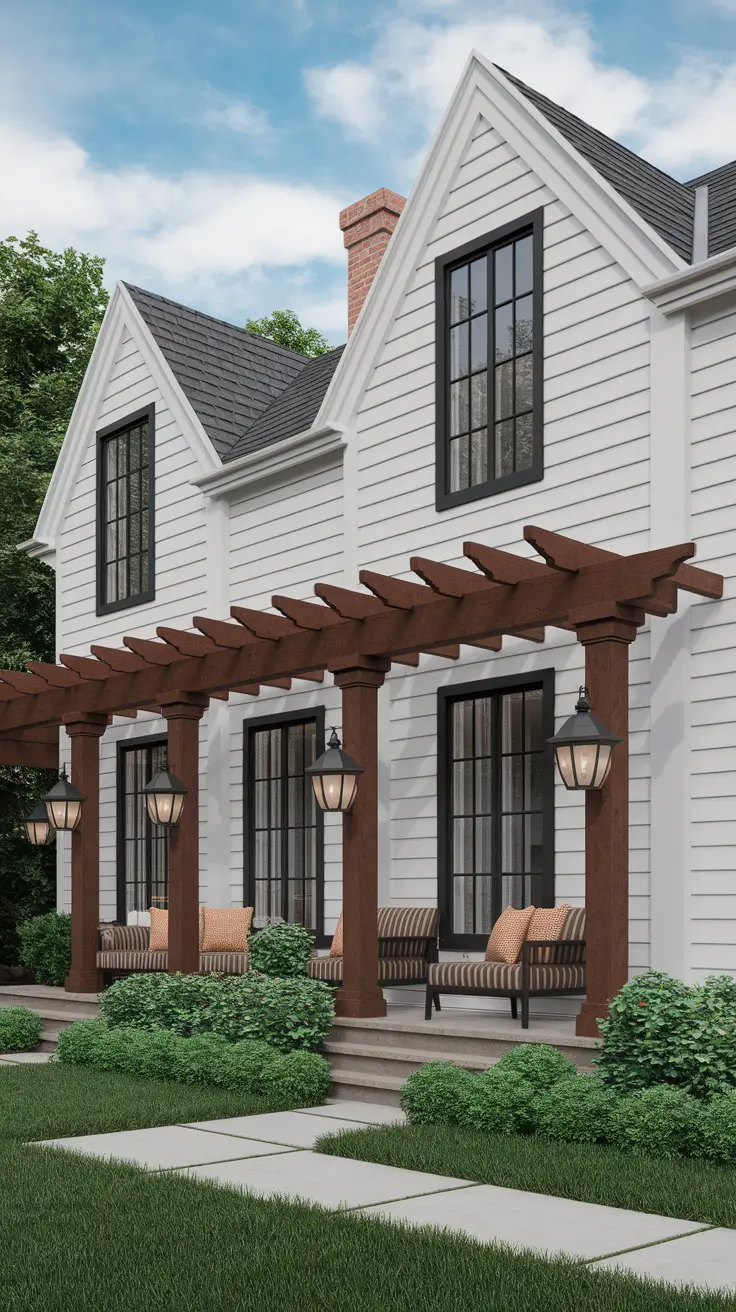
I really enjoy how adaptable a white base is. It’s like a blank canvas that can be styled rustic, modern, or even antique depending on your design vision. Veranda magazine recently pointed out that white can help make small homes look more open and tidy which I’ve also noticed myself.
If you’d like to finish the look, you can add architectural lighting that highlights the architecture such as lights on the walls or numbers near the entrance.

Crafting The Perfect White Exterior House Color Palette
Building a cohesive white exterior house color pallet means thinking beyond white itself. My first step is to set up a white base and then add in other colors throughout the trim, roof, windows and accessories. Done right, the result feels balanced, not bland.
I would suggest using a light greige white on your walls, a darker grey or brown for the trim and shutters and a strong door color like muted teal or iron black. You can also use stone skirting or natural wood slats to ground the colors in your space. It’s important to keep the colors working well together, so use no more than three or four base tones.
I have found that these pre-made color schemes help to unify a design and make it less busy. I get a lot of my ideas from the palettes on Houzz and the boards on Pinterest made by Shea McGee. I like that the brands usually give the exact names of the paints.
A final tip? Test your sample colors by setting them all out on an outdoor board during the day. Bringing your colors together is the best way to make sure they don’t clash.
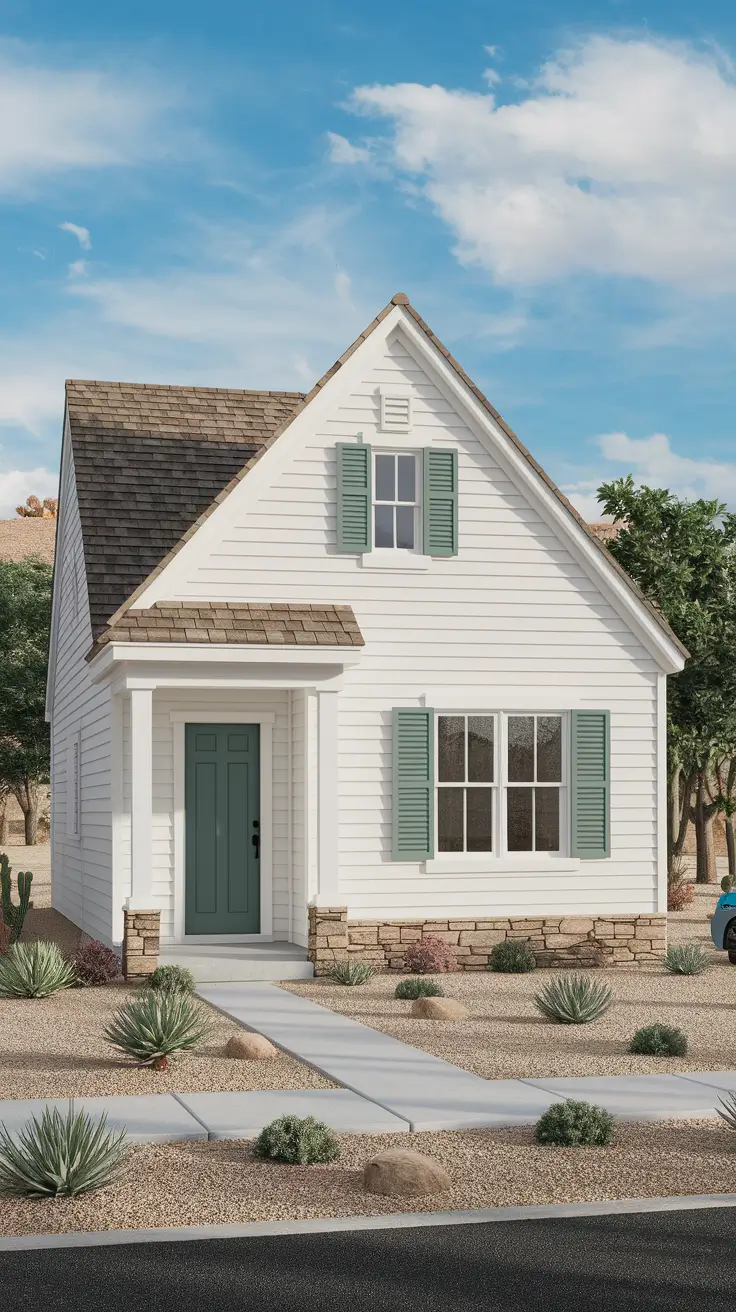
White Exterior House With Natural Stone Touches
Blending a white exterior house with stone is one of the most natural ways to elevate curb appeal. In my experience, mixing painted white walls with rough stone gives any space a refined and solid look. Because of its texture, the stone provides depth and strength to the white color.
I often put stone around the foundation, on top of chimneys or to border the entrance path when I design. Limestone with a cool color, neutral fieldstone or ledgestone stacked up can all look amazing. It’s important to pick a stone that matches the white in your home, avoiding anything too orange or yellow. Include timber lintels and cedar garage doors and the home has a welcoming yet impressive look.
A recent visit to a property in Colorado showed me white stucco walls and trim made from river rock and slate. It was a masterclass in material blending. House Beautiful pointed out that using stone can give a home a touch of luxury, is eco-friendly and comes from local sources.
I also recommend using the stone as part of outdoor furniture such as fire pits, garden walls or planters, to create a continuous look in your yard.
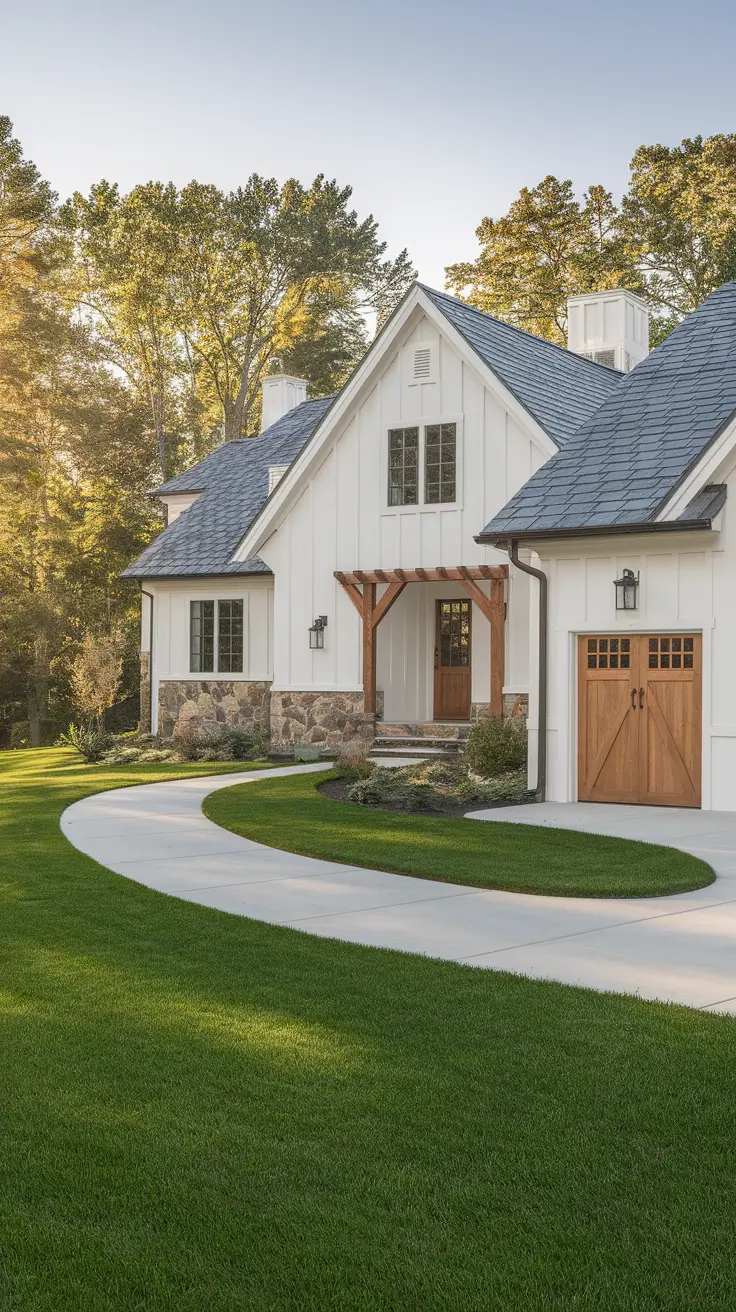
Dramatic Contrast: White Exterior House With Black Windows
A white exterior house with black windows offers drama, contrast, and crisp definition. People who like a modern design with a simple base will appreciate this style. The black trim highlights the house’s structure and matches any size or design of window.
I’ve applied this design to both tall two-story houses and low-lying single-level ranches. I often suggest using black aluminum frames with big panes, so you can let in plenty of light. A white exterior makes the building stand out, but it doesn’t feel too strong. I usually end by putting black door knobs on and adding charcoal-colored planters to tie everything together.
For me, black windows have the greatest effect on a home’s look. Dwell magazine refers to this as the main highlight of a modern exterior and I think it’s true. It’s low-maintenance and rarely goes out of style.
What completes this look? Clean landscaping and minimal distractions. It’s best to avoid having colorful elements fight with the bold contrast in the image. Think boxwoods, river stones, and structured walkways.
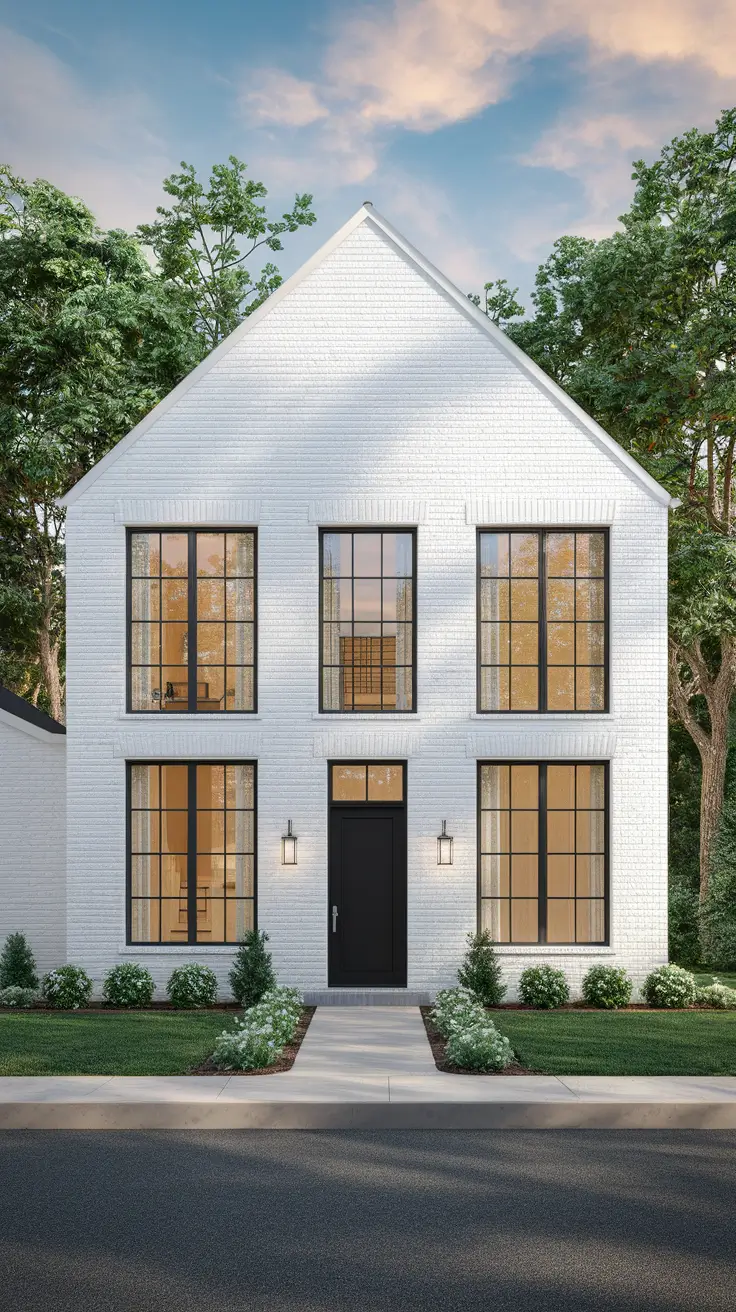
Bold And Elegant: White House With Black Accents
If you want to make a statement, opt for a white house with black accents. This combo is bold yet timeless. It fits beautifully with farmhouse, industrial and modern minimalist styles. Black trim, shutters, gutters and lighting make the home’s shape and structure stand out.
I often use matte black porch rails, carriage-style lights for the garage and strong shades of navy or charcoal for the door in my designs. Richness and interest are also added by painting the porch ceiling or soffits black. If the accents are the same all around the exterior, the effect looks more polished.
Design-wise, this style is a crowd-pleaser. People I work with often tell me how much better their homes look and how great the pictures turn out. Homes with black accents are frequently chosen by HGTV as top examples of today’s curb appeal.
You might also want to try different textures such as matte versus satin blacks or using metal and wood together, to prevent your room from looking dull.
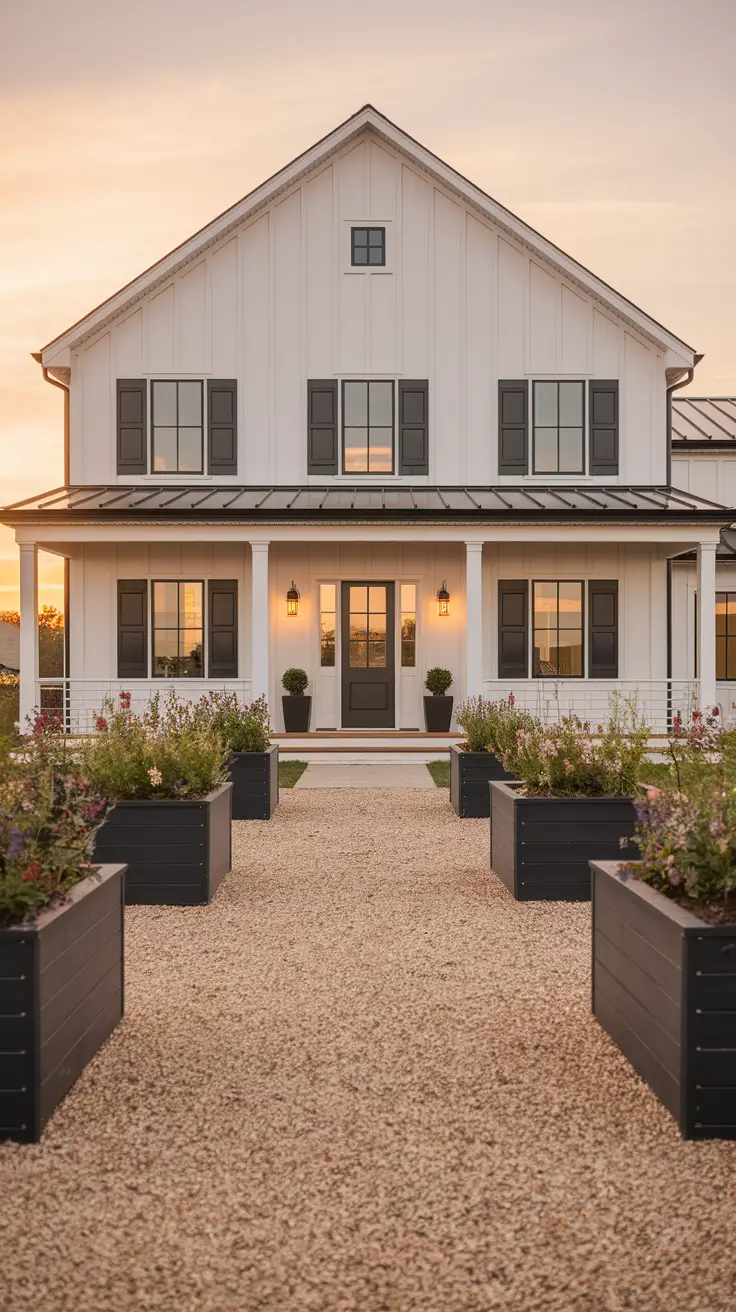
The Art Of Pairing White With Black Trim
Pairing white with black trim is about achieving perfect contrast without visual clutter. I tell clients that it’s similar to putting on eyeliner—it makes the eye stand out without being too strong. It looks great in modern townhomes as well as transitional cottages.
I focus on precision in execution. To ensure harmony, all black window casings, fascia boards, soffits and shutters should be painted in the same way. The best color for smooth white siding is Alabaster or Super White. Warm lighting and medium-toned landscaping help to soften the big difference between light and dark areas.
I personally like this combination best when selling items. It’s memorable, clean, and universally appealing. Architectural Digest described it as Instagram’s most popular duo and I’ve noticed that in the requests I get from clients.
If you’d like to enhance this style, add a Dover white ceiling to the porch for a gentle change or add horizontal railing in matte black.
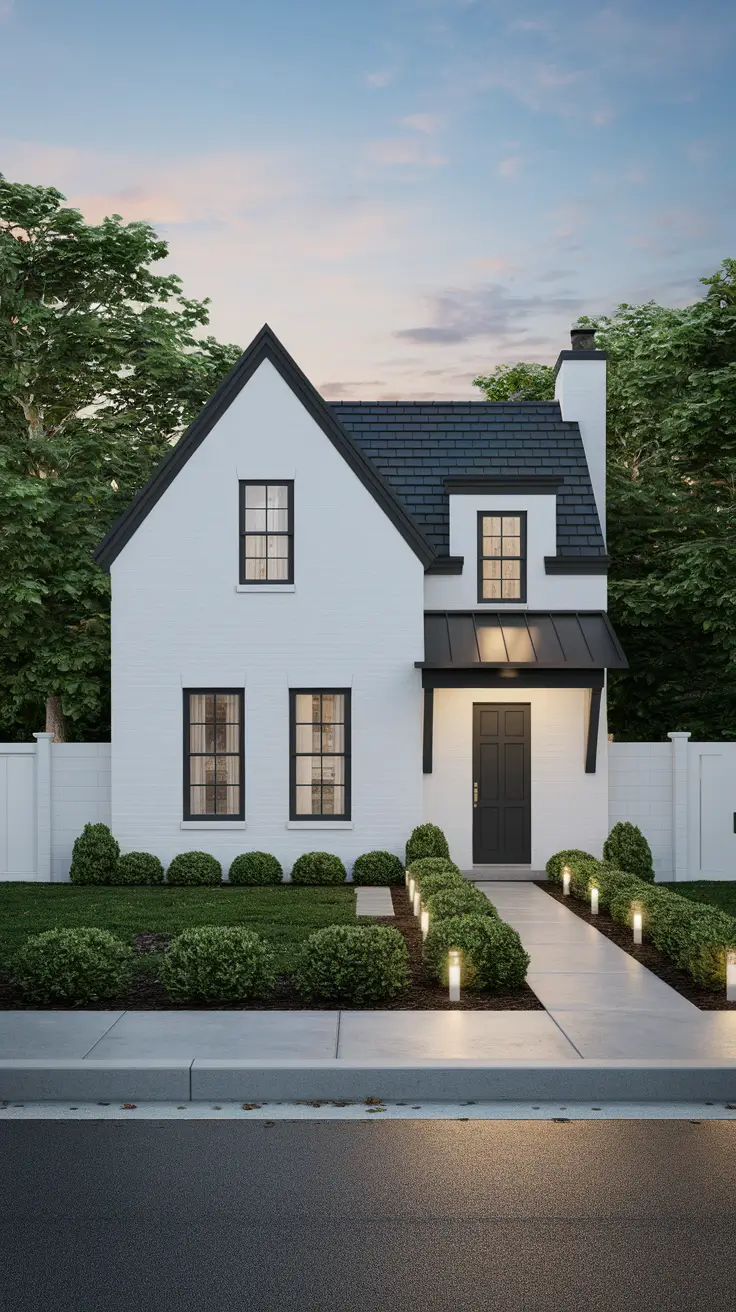
Grey And White Exteriors That Speak Sophistication
A white house exterior looks best when paired with grey and white. I like that it dims the white and gives the walls more depth. Often, I advise using soft charcoal or warm greige siding as the lower part of the home or as accent panels. It looks great, never goes out of style and is perfect for use in townhouses or large houses in the suburbs. The color scheme looks great on both old and new styles of architecture.
I prefer to use grey trim that’s smooth and paint the main parts of the house in crisp white. A grey slate roof and painted shutters will help the house look balanced. A set of light ash stone steps adds a final touch to the whole space. Adding decorative planters or black sconces to this color combination helps without cluttering the clean lines of the house.
I have found that adding grey to white makes the airy quality more stable. I’ve applied this palette to both Cape Cod-style houses and contemporary ranch houses with the same results. Architectural Digest suggests using warm greys in houses surrounded by trees, since it helps the home blend with its environment. For many of my clients, this advice has been very accurate.
You could try adding a darker trim such as pewter or black, to the room. A secondary layer of smooth grey stucco will make the white lap siding stand out with a beautiful contrast.

Cozy And Warm: White Exterior With Brown Tones
If you hope to make your white exterior house feel warm and cozy, adding brown colors is an excellent idea. I’ve relied on this palette to build warm country homes and attractive craftsman styles. Brown brings a rich and natural look to any space and looks best in wooded or rural areas. Choose soft white walls, brown wooden beams and natural fiber materials to give your home a farmhouse look with a modern edge.
The main features in this design are stained cedar gables, timber posts and a rustic front door. I also use bronze or oil-rubbed bronze hardware and sconces in my designs. Painting horizontal siding white, using Dover White or similar colors and topping it with dark shingles or a brown roof will make the palette look great together. A stone pathway and some planters can complete the look of your garden.

Brown wood accents in my projects make things more comfortable to touch and divide the white space without making it less bright. Southern Living points out that using warm colors outside is popular again and I think that’s because it brings both comfort and natural beauty.
To make this look better, I’d suggest using brick or stone and maybe putting a wood swing or woven furniture set outside on the porch.
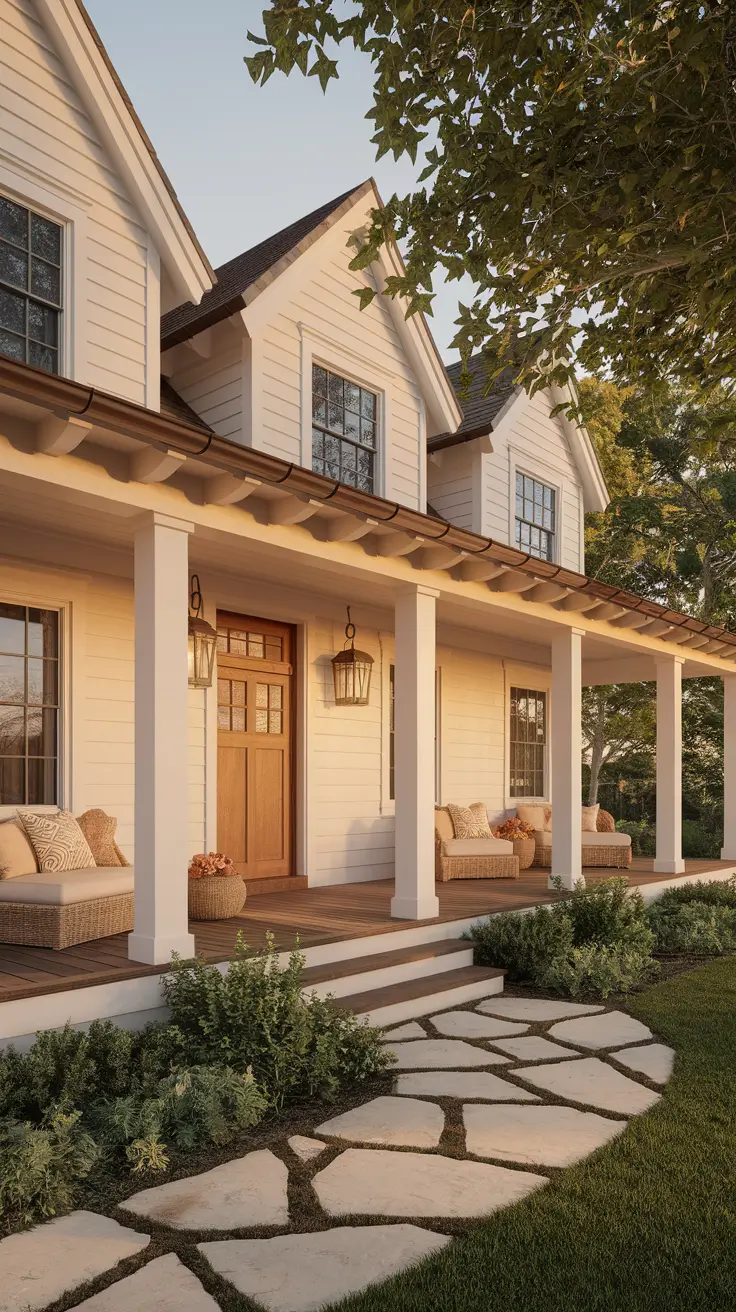
Best Front Door Colors For A White Exterior House
The color of your door is a great way to add some character to a white exterior home. I regularly tell clients that the front door should be the main attraction, since it can set the mood for the whole home. Any color will look good on a white background, but I like to use bold ones to make the most of it. Adding navy, olive green or terracotta to neutral colors can make your home’s exterior more interesting.
I love seeing a white house with black trim and a cherry wood or dark turquoise door. They look amazing against a neutral background and match both natural and painted finishes. Matte black hardware and brass knockers or handles give your door a stylish and elegant look.
I believe that deep hues help highlight the architecture or unique features of a space. Better Homes & Gardens suggests “a dark or vibrant hue will act as a beacon, creating interest without overwhelming the structure”—and I’ve seen this play out beautifully in countless projects.
I’d also suggest adding house numbers or a wreath to the door to make the house look even better from the street.

Painting Tips For Long-Lasting White Exteriors
To keep a white exterior house looking good, use the proper painting methods and materials. I begin by selecting a good exterior paint that won’t grow mildew. Because bright whites are likely to fade or change color, taking care with the application is very important. Pressure washing and sealing the surface before you paint will make your finish last much longer.
I suggest using a sprayer on big areas and angled brushes for the edges and corners. Using a primer is a must, especially if you’re covering darker colors or applying over raw wood. For me, trim color and siding edges look best with satin or semi-gloss finishes because they are tough and easy to clean.
It seems to me that choosing Benjamin Moore’s Aura or Sherwin-Williams Duration for your paint is worth the money over time. They resist the sun well and are easier to clean than other products. According to Houzz, painting should be done every 5–7 years and my clients who do so enjoy great results that last.
It’s important to look for water damage or cracks before you start painting. This approach will save you money and help your paint go on smoothly.

Complementary Trim Colors For White Houses
Choosing the right trim color for your white exterior house matters as much as choosing the main paint. I’ve noticed that using black trim, soft beige or smoky blue can make a white home look very different. If executed properly, trim enhances the look of your home, outlines architectural features and matches the bright white paint.
I like to match trim with architectural features. Black trim looks great when used on colonial or modern homes that are symmetrical. Using cream or light grey trim helps to soften the room and looks great with Dover or off-white colors. It’s necessary to use the same trim color on eaves, railings and shutters to keep everything looking unified.
I have found that trim color can change the overall mood of a design. A recent feature by House Beautiful highlighted a white Tudor home with dark sage trim and it turned out beautifully. I’ve followed this same method in colder areas where green or slate fits in nicely with the environment.
I recommend not going with all white on white, unless that’s the look you’re going for. Using a little difference can help your design look finished.

Creating A Modern Look With A White Exterior
I usually begin a modern and clean look by using bold lines and a little contrast on a white house. Since modern homes are simple and symmetrical, I use flat or slatted siding in white exterior house paint colors such as Pure White or Ultra White. Black-framed windows and steel details are what make the house look so modern.
I enjoy designing homes that have smooth stucco, simple landscaping and cantilevered roofs. If I’m picking furniture or outdoor decorations, I go for a sleek look: black benches, planters with geometric shapes and lanterns made of clear glass. The pavers in the driveway are usually dark slate to make the home’s brightness stand out.
Modern white homes are visually striking and very livable. Dwell magazine points out that modern white houses can make it hard to tell where the inside ends and the outside begins and I try to do the same in my own work. Large windows, accessible terraces and single-color furniture help create that feeling.
Finish the look with simple outdoor lighting and add smart features such as motion lights or pads that let you enter your home without a key.
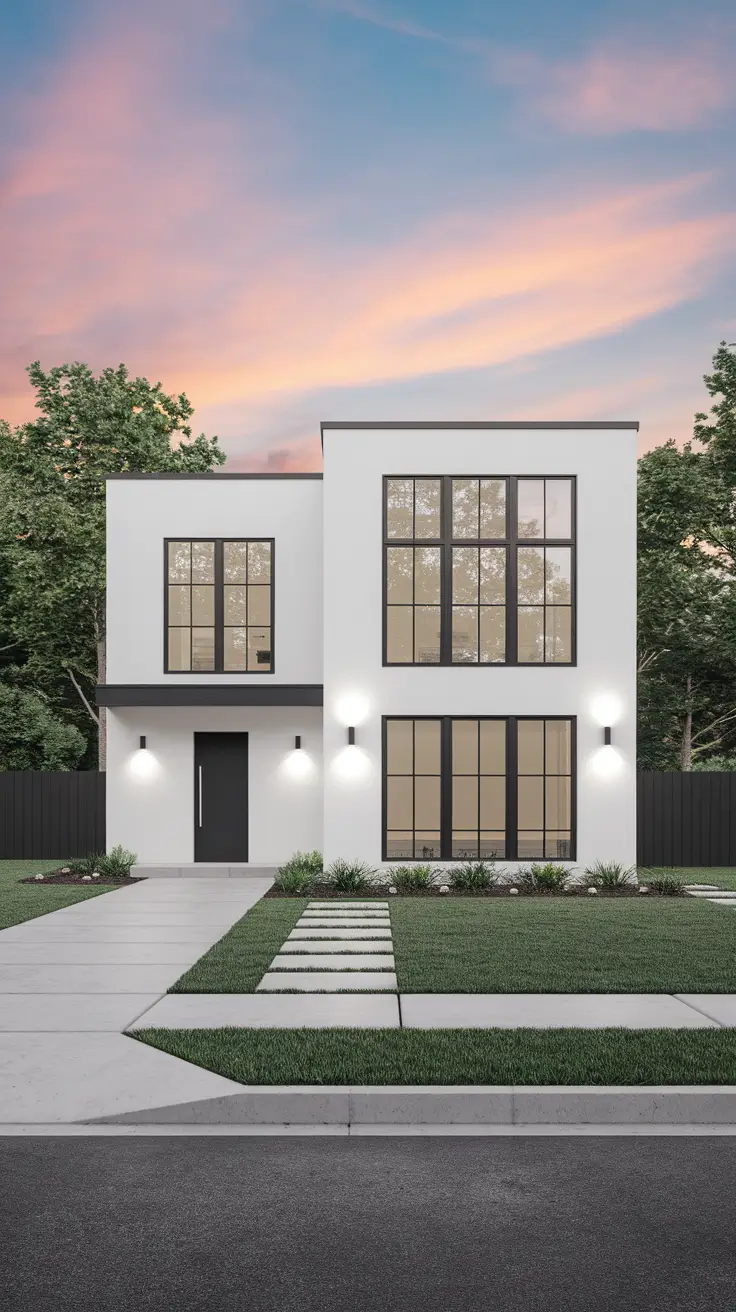
Rustic-Inspired White Exterior House Designs
A white exterior house with rustic details can give you the look of the countryside without seeming outdated. I often use whitewashed brick, lime plaster and weathered wood, along with stone pathways. Its charm comes from its natural aging, so it’s simple to keep up and looks unique.
Many times, you’ll come across timber porch posts, shiplap siding and exposed rafters. I add aged bronze lanterns, reclaimed barn doors and brown roofs or shutters to my designs. Using a lot of white on walls helps the rustic elements stand out. The final touch is earth-toned landscaping, with gravel, rosemary bushes and clay pots adding a lot to the space.
This look is about comfort. I have helped design homes with porches that go all the way around and wide wooden decks that look like they’ve been there for a long time. The Spruce says rustic homes “connect people with the past,” and that resonates with me. There’s something grounding about this approach.
A climbing ivy, an old sign or an antique rocking chair would make this place complete.
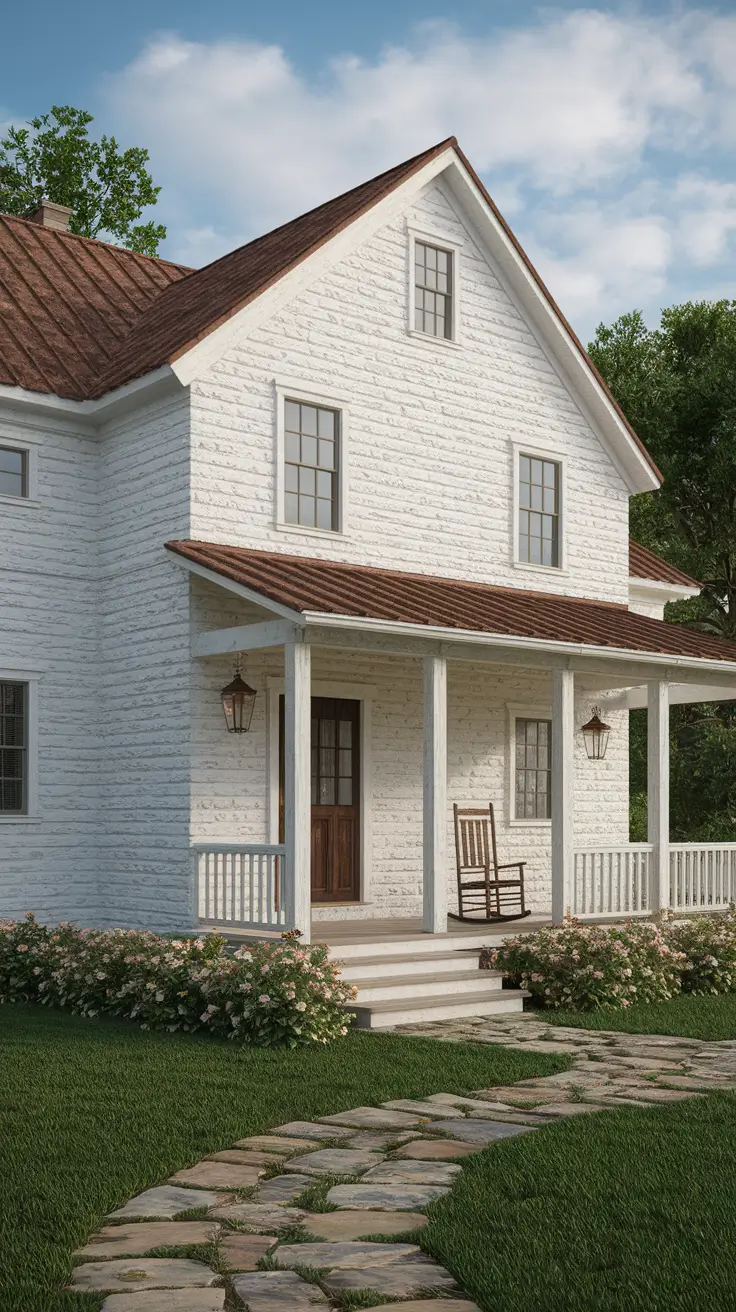
Save Pin
